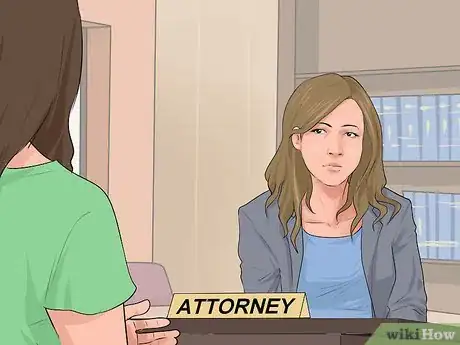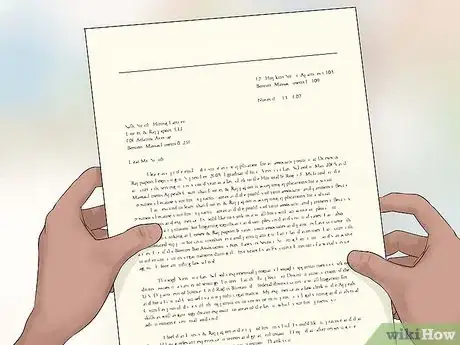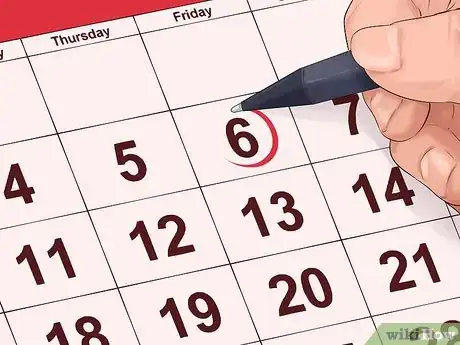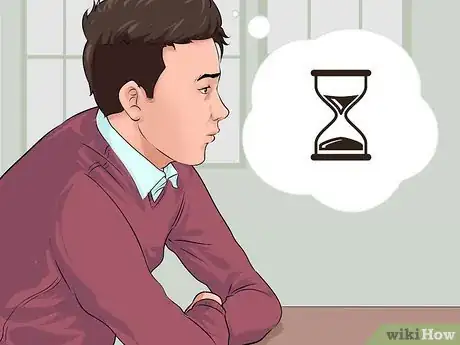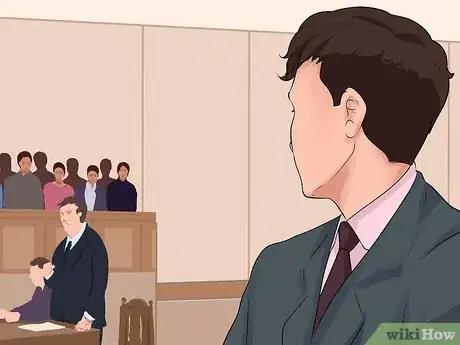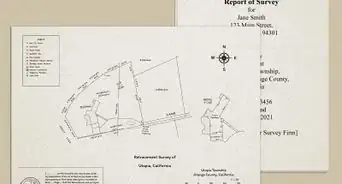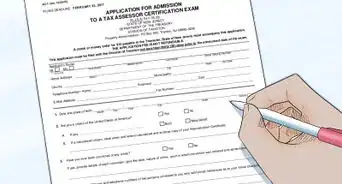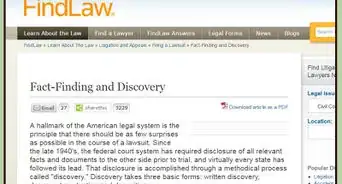This article was written by Jennifer Mueller, JD. Jennifer Mueller is an in-house legal expert at wikiHow. Jennifer reviews, fact-checks, and evaluates wikiHow's legal content to ensure thoroughness and accuracy. She received her JD from Indiana University Maurer School of Law in 2006.
There are 9 references cited in this article, which can be found at the bottom of the page.
This article has been viewed 23,212 times.
An easement gives another party the right to use specific parts of your land for a designated purpose. Sometimes easements are detailed in property deeds, but often they may be contained in a separate document. To confuse things further, an individual or company may gain the right to an easement by operation of law or simply as a result of using the land for a period of time without the landowner stepping forward to prevent that use. Because an easement can significantly affect your property rights and the value of your land, it's important to act quickly to settle property easement disputes.
Steps
Evaluating Your Property Rights
-
1Have a full title search performed. Property title refers to all ownership documents, including your deed. A title search will reveal any previous agreements regarding easements on your property.[1]
- You can Search Property Titles on the Internet yourself, or you can hire a title search company to complete the search for you.
- An easement must be recorded, but it would be a separate document from the deed itself. Be on the lookout for any document containing the word "easement." That document will describe the property subject to the easement and the purpose of the easement.
- If you find the applicable easement, but you want to end it, review the terms recorded in the easement. You may have to negotiate with the other party to end the easement early.
- Keep in mind that someone also can gain an easement through adverse possession, in which case you wouldn't find a recorded document. This is particularly a risk if the individual or company has been using a portion of your land for several years and you haven't done anything to stop them.
-
2Hire a licensed surveyor. You may want to have a surveyor physically locate and mark your property boundaries as reflected in your deed.[2]
- The surveyor will mark the boundary lines of your property, which will tell you how much of your property is subject to the disputed easement.
- For example, if your neighbor claims an easement to use a beach-access path that starts on her property and runs through your backyard, the easement only covers the portion of the path in your yard.
- You typically can search the website of your state's licensing board to find a licensed surveyor. Expect to pay around $500 for the survey, depending on the size of your lot.[3] [4]
Advertisement -
3Get an appraisal. A professional appraisal can help you determine the value of the property that is subject to the easement dispute.[5]
- Keep in mind that even if you had an appraisal done when you bought the house, property values change over time. If it's been several years since you got an appraisal, you should consider getting a new one.
- Check with professional associations such as the Appraisal Institute to find a reputable appraiser. Most have searchable membership directories on their websites.
- Typically you'll get an appraisal of your entire property. Then you can divide the total by the square footage or acreage of your lot to get the value per square foot or per acre. Use that figure to determine how much the property subject to the easement is worth.
-
4Consider consulting an attorney. An experienced real estate attorney can help you analyze your property documents and understand your rights with respect to your land and its use.
- Easement disputes can be complex and drawn-out, depending on the issues at stake. While it may be a relatively simple matter to negotiate with a neighbor over something like a hiking path or beach access route that crosses your property, negotiations with large corporations or that involve utilities or mineral extraction can be far more difficult.
Negotiating with the Other Party
-
1Send a letter to the other party. For the most part, you should keep your interactions regarding the property easement dispute in writing.
- Include your basic understanding of the dispute, and what you think should be done to resolve it.
- If you're the one seeking an easement, explain why you need it. For example, maybe you can't reach the main road from your property without using your neighbor's driveway.
- If the other party is using your property, indicate that you don't want to grant an easement and explain why it would disrupt or damage your own use of your property.
- Offer to share any legal documents or other information you've uncovered in your research when you meet to discuss the situation.
-
2Schedule a face-to-face meeting. Negotiations generally fare better when the two parties can meet in person and discuss the issues at hand.[6]
- A neutral location typically is best, because one party doesn't have an advantage over the other. For example, if you're negotiating an easement dispute with a utility company, you may not want to meet a company representative in the company's main office.
- However, especially if you're negotiating with a company, keep in mind that they may have more information and materials available at their office.
- At your meeting, remember to be courteous and respectful of the other party. Keep your tone professional and avoid hurling insults or getting overly emotional.
-
3Share the information you've gathered. Provide the other party with the results of your title search, survey, and other information regarding the value of the property in dispute.[7]
- Disputes are more easily resolved when both parties have access to the same information. If the other party is operating under a misunderstanding about the easement, legal documents may be adequate to clear the situation up.
- Use diagrams or maps to demonstrate why the easement is necessary, or, if it's your property, why the easement would cause a disruption to your use of your property.
-
4Allow the other party to conduct an independent assessment. The other party may want to have his or her own survey or appraisal to confirm or compete with yours.[8]
- If the other party wants additional information or another professional assessment, provide a reasonable deadline to complete that process. This ensures the request is legitimate and not just a stall tactic.
- Having things completed more quickly may be a bigger issue if the clock is ticking on adverse possession. If the other party has been using your property for a long period of time without anyone saying anything about it, this is something to keep in mind.
-
5Evaluate options for resolving your dispute. Once you have all the information about the disputed property, you can determine how best to settle the situation.[9]
- Keep in mind that different easements exist for different purposes. If you can find a way to accomplish the same purpose for which the easement is being used without the easement, you may be able to resolve the dispute that way.
- In some cases you also may be able to restrict the time period of the easement, rather than the easement itself. For example, if your neighbor needs to cut through your yard to get to the main road, but can lay his own driveway around the corner and out to the road, you may want to continue the easement until your neighbor has had enough time to build that driveway out.
-
6Create a written agreement. If you and the other party are able to reach a settlement on the easement dispute, make sure its terms are put into a written agreement you both can sign.
- If you're drafting an easement agreement between you and your neighbor, make sure it has a reasonable date when it will end – you probably don't want it to run with your property forever.
- You also can make the easement end upon your selling of the property, or when your neighbor sells his or her property.
- If the easement changes your property rights, you must execute a new deed describing the easement and file it in your county recorder's office with the original deed.
Using Alternate Dispute Resolution
-
1Discuss alternate dispute resolution (ADR) with the other party. If you're unable to resolve the situation on your own, ADR may provide you a way to reach settlement without the time and expense of litigation.[10] [11]
- Send a letter to the other party and indicate that you'd like to use ADR rather than filing a lawsuit.
- You can make this request even if the other party has already sued you – just make sure you answer the lawsuit before the deadline so he or she doesn't win the lawsuit by default while you're trying to take an alternate path to settlement.
-
2Choose mediation or arbitration. Because the two main forms of ADR have their own benefits and drawbacks, you and the other party may prefer one method to the other.[12] [13]
- Arbitration is very similar to a trial, in that each party presents its case and an arbitrator (sometimes a panel of three) decides what the outcome should be. However, unlike a trial, the rules of evidence and procedure are somewhat relaxed.
- Mediation is a non-adversarial process in which a neutral third party assists you and the other party in coming to a mutually agreeable settlement.
- With arbitration, the decision of the arbitrator is legally binding on both you and the other party – even if you don't agree with it. However, in mediation, there is no requirement to come up with any resolution at all and acceptance of a settlement is voluntary.
- If your easement dispute is with a neighbor, you may prefer mediation because the non-adversarial nature enables you to continue good relations.
- Companies may prefer arbitration because the result is binding and they can be assured that the arbitrator has property law experience.
-
3Search for local resources. Many cities and states have agencies to assist property owners in resolving easement disputes.
- Your city or county office may have information about ADR services in your area. You also typically can find lists of ADR providers by talking to the clerk of your local court.
- Your local bar association also may have information about ADR available. Check its website for links to mediation or arbitration.
- Some community ADR programs are free, but generally you should expect to pay anywhere from several hundred to several thousand dollars for an ADR session. The cost will depend on the complexity of your dispute and how long your session lasts. Typically you and the other party would split this cost.[14] [15]
-
4Participate in your ADR session. Arrive at the court or service center at your appointed time with documents and information to support your position.[16] [17]
- The procedure will differ depending on whether you chose mediation or arbitration. Arbitration hearings run much like a trial, although there generally are fewer formalities.
- In contrast, mediation is a more casual back-and-forth in which you and the other party will discuss the dispute and attempt to find a reasonable compromise.
- Generally, you'll need to prepare an opening statement discussing the easement dispute as you see it and what your preferred outcome would be.
- You also should bring any documents or other information pertaining to the value of your property or the easement at issue. Depending on the type of easement, you might consider taking photos of the property.
-
5Get any settlement in writing. If you come to an agreement with the other party, make sure the agreement is legally binding.
- If you choose arbitration rather than mediation, the arbitrator's decision automatically will have legal authority over both you and the other party.
- Any agreement reached through mediation should be put in writing. Typically the mediator will do this for you, but read over it and make sure it reflects the agreement as you understand it.
- Once you and the other party have signed your mediation agreement, there may be additional steps you must take to make it legally enforceable.
- For example, if your agreement involves a change in property rights as a result of the disputed easement, those rights must be recorded in a new deed filed with your county recorder's office.
-
6File a lawsuit. If you are the property owner and you are unable to resolve the dispute through negotiation or ADR, you may have to file a quiet title lawsuit so a judge can resolve the issue.[18]
- To begin a quiet title lawsuit, you must file a complaint or petition in the local court with jurisdiction over the property. Many courts have forms you can fill out to start the process.[19]
- A quiet title lawsuit is designed to literally "quiet" any dispute regarding use or ownership of land. When you file your lawsuit, you must serve the individual or company with whom you have the easement dispute.
- In many cases, you also must post notice on the property as well as in the local newspaper.
- The judge will review the use of the property and the results of your title search to determine whether the other party legally has an easement that should be recorded, or whether the other party's use should cease.
References
- ↑ http://www.nolo.com/legal-encyclopedia/what-can-you-do-about-boundary-dispute-with-neighbor.html
- ↑ http://www.nolo.com/legal-encyclopedia/what-can-you-do-about-boundary-dispute-with-neighbor.html
- ↑ http://elsweb.kyboels.ky.gov/kboels-web/Searchable-Roster.aspx
- ↑ http://www.homeadvisor.com/cost/architects-and-engineers/hire-a-land-surveyor/
- ↑ http://www.nolo.com/legal-encyclopedia/what-can-you-do-about-boundary-dispute-with-neighbor.html
- ↑ http://www.nolo.com/legal-encyclopedia/what-can-you-do-about-boundary-dispute-with-neighbor.html
- ↑ http://www.nolo.com/legal-encyclopedia/what-can-you-do-about-boundary-dispute-with-neighbor.html
- ↑ http://www.nolo.com/legal-encyclopedia/what-can-you-do-about-boundary-dispute-with-neighbor.html
- ↑ http://www.nolo.com/legal-encyclopedia/what-can-you-do-about-boundary-dispute-with-neighbor.html
- ↑ http://www.nolo.com/legal-encyclopedia/arbitration-basics-29947.html
- ↑ http://www.nolo.com/legal-encyclopedia/mediation-six-stages-30252.html
- ↑ http://www.nolo.com/legal-encyclopedia/arbitration-basics-29947.html
- ↑ http://www.nolo.com/legal-encyclopedia/mediation-six-stages-30252.html
- ↑ http://www.calbar.ca.gov/Public/Pamphlets/ResolveaDispute.aspx#10
- ↑ http://www.nolo.com/legal-encyclopedia/divorce-mediation-faq-29035-6.html
- ↑ http://www.nolo.com/legal-encyclopedia/arbitration-basics-29947.html
- ↑ http://www.nolo.com/legal-encyclopedia/mediation-six-stages-30252.html
- ↑ http://www.nolo.com/dictionary/quiet-title-action-term.html
- ↑ https://www.courts.phila.gov/pdf/forms/fraudulent-conveyance-quiet-title-packet.pdf



